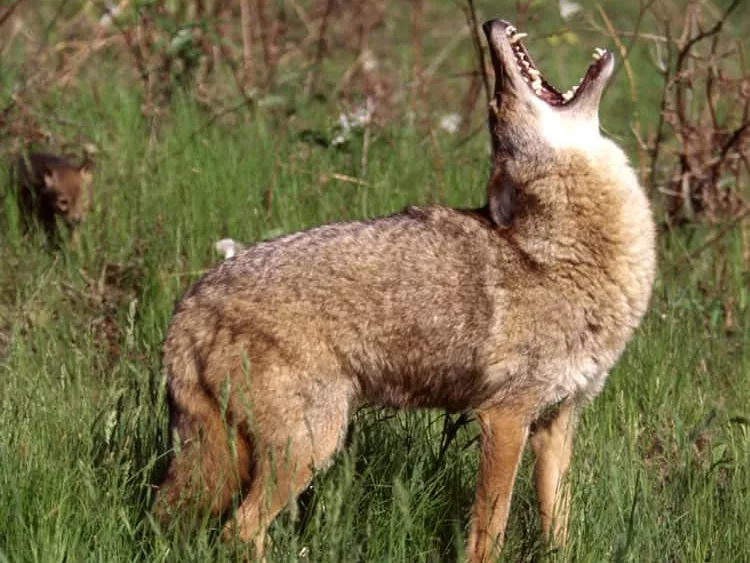I have such mixed feelings on coyotes…one side of me wants to get rid of them, while the other side admires them for their cunning and intelligence. Unfortunately they are overrunning Kentucky and Tennessee. Kentucky officials say they are turning calves, foals and even small dogs and cats into their prey.
 They've taken over some areas, killing the small game, the rabbits, the pheasants; and they're becoming a major problem. You can hunt coyotes year round in Kentucky and Tennessee and there is no bag limit, but it's not a good idea unless you're a good hunter. They are the most adaptable wildlife species on this continent. Until the late 1970s, coyotes weren't even in Kentucky. A coyote is similar to a small wolf and was able to get into Kentucky when the Mississippi River froze over in the 1970’s. Today, it is present in every county in the state. As their numbers grew and their range expanded, wildlife officials began to take note some changes in their behavior. Years ago, coyotes were active in the daytime.
They've taken over some areas, killing the small game, the rabbits, the pheasants; and they're becoming a major problem. You can hunt coyotes year round in Kentucky and Tennessee and there is no bag limit, but it's not a good idea unless you're a good hunter. They are the most adaptable wildlife species on this continent. Until the late 1970s, coyotes weren't even in Kentucky. A coyote is similar to a small wolf and was able to get into Kentucky when the Mississippi River froze over in the 1970’s. Today, it is present in every county in the state. As their numbers grew and their range expanded, wildlife officials began to take note some changes in their behavior. Years ago, coyotes were active in the daytime.
But because people have spread throughout the country and taken over their habitats, they are now largely nocturnal. They eat mostly small animals and berries but occasionally will attack larger prey. Coyotes generally avoid humans, and while attacks on people have been recorded, they are rare. The biggest problem with the animals is that they "overeat" an area, killing all the small wildlife, then move on, leaving an area without many animals that were native to it. These adaptable animals will eat almost anything. They hunt rabbits, rodents, fish, frogs, and even deer. They also happily dine on insects, snakes, fruit, grass, and carrion.
 Many ranchers and farmers regard them as destructive pests because they sometimes kill lambs, calves, or other livestock, as well as pets. Another change in their behavior is that they have learned to hunt in packs more often. This enables them to bring down larger animals such as full grown deer and sheep. Coyotes are formidable in the field where they enjoy keen vision and a strong sense of smell. They can run up to 40 miles an hour, are known to be good swimmers and can live up to 14 years in the wild. They are versatile and I have personally seen them climb a 6 foot chain link fence. Coyotes normally mate in early spring and can be more aggressive when mating. It is wise to keep a safe distance from the animals during this time. The most serious problem is that the animals may become used to people. As they lose their fear of people, they will become bolder in approaching people and may put themselves in hazardous situations they would normally avoid. Coyotes, if fed regularly by people, will come to depend on people for their food. They won't starve if you stop feeding them, but they will be hungry and unafraid of people. They can get very aggressive in approaching other people. The most danger is in urban areas where young coyotes have learned to steal and beg for food.
Many ranchers and farmers regard them as destructive pests because they sometimes kill lambs, calves, or other livestock, as well as pets. Another change in their behavior is that they have learned to hunt in packs more often. This enables them to bring down larger animals such as full grown deer and sheep. Coyotes are formidable in the field where they enjoy keen vision and a strong sense of smell. They can run up to 40 miles an hour, are known to be good swimmers and can live up to 14 years in the wild. They are versatile and I have personally seen them climb a 6 foot chain link fence. Coyotes normally mate in early spring and can be more aggressive when mating. It is wise to keep a safe distance from the animals during this time. The most serious problem is that the animals may become used to people. As they lose their fear of people, they will become bolder in approaching people and may put themselves in hazardous situations they would normally avoid. Coyotes, if fed regularly by people, will come to depend on people for their food. They won't starve if you stop feeding them, but they will be hungry and unafraid of people. They can get very aggressive in approaching other people. The most danger is in urban areas where young coyotes have learned to steal and beg for food.
 If they can't find food, then the small animals in the neighborhood will become their targets to solve their need for food. Children will also be at risk of being bitten. Coyotes are not your average dog — they are not to be messed with. They are smart, and they learn quickly. They can be dangerous, and when it comes to urban coyotes, steps should be taken to avoid encouraging them to visit your neighborhood. That means close garbage can lids tightly, do not leave pet food outside and do not leave small pets outside unaccompanied. Coyotes love nothing better than cats and frequently take small dogs. While they have been known to interbreed with dogs and produce “Coydogs”, they are MUCH less common than people think. That happens in nature if a coyote can't find a mate, it will breed with a domestic dog. More often than not, a coyote would rather eat a dog than mate with it! So if you have coyotes nearby, try to keep your animals inside if at all possible, and if you've got a fence at least 6 feet high. They like to dig, so make sure that fence is a foot below ground. Coyotes can also interbreed with wolves. There are two separate animals that most likely resulted from this: the Eastern coyote and the Red Wolf. There is thought to be a population of red wolves in Kentucky’s Land Between the Lakes and they are a protected species.
If they can't find food, then the small animals in the neighborhood will become their targets to solve their need for food. Children will also be at risk of being bitten. Coyotes are not your average dog — they are not to be messed with. They are smart, and they learn quickly. They can be dangerous, and when it comes to urban coyotes, steps should be taken to avoid encouraging them to visit your neighborhood. That means close garbage can lids tightly, do not leave pet food outside and do not leave small pets outside unaccompanied. Coyotes love nothing better than cats and frequently take small dogs. While they have been known to interbreed with dogs and produce “Coydogs”, they are MUCH less common than people think. That happens in nature if a coyote can't find a mate, it will breed with a domestic dog. More often than not, a coyote would rather eat a dog than mate with it! So if you have coyotes nearby, try to keep your animals inside if at all possible, and if you've got a fence at least 6 feet high. They like to dig, so make sure that fence is a foot below ground. Coyotes can also interbreed with wolves. There are two separate animals that most likely resulted from this: the Eastern coyote and the Red Wolf. There is thought to be a population of red wolves in Kentucky’s Land Between the Lakes and they are a protected species.
 Coyotes do only two things that wolves & dogs don't do. They have a "gape" (hold their mouth open), when they feel threatened and they can make a hissing noise like a cat. If there are coydogs in a pack, they are more dangerous to humans. This is because coydogs do not have the natural fear of man like a full blooded coyote does. Packs are becoming more brazen and are coming into yards in neighborhoods at night. This recently happened to me at 2 AM one morning. But I am not foolish enough to go out at night and find myself surrounded by a pack. As I said earlier, attacks on humans are rare but not unheard of, especially if you are dealing with coydogs among them. Still…coyotes are beautiful, intelligent animals and deserve a place in our world. Please feel free to leave comments and be sure to hit the "Like" button at the end of this post..
Coyotes do only two things that wolves & dogs don't do. They have a "gape" (hold their mouth open), when they feel threatened and they can make a hissing noise like a cat. If there are coydogs in a pack, they are more dangerous to humans. This is because coydogs do not have the natural fear of man like a full blooded coyote does. Packs are becoming more brazen and are coming into yards in neighborhoods at night. This recently happened to me at 2 AM one morning. But I am not foolish enough to go out at night and find myself surrounded by a pack. As I said earlier, attacks on humans are rare but not unheard of, especially if you are dealing with coydogs among them. Still…coyotes are beautiful, intelligent animals and deserve a place in our world. Please feel free to leave comments and be sure to hit the "Like" button at the end of this post..





